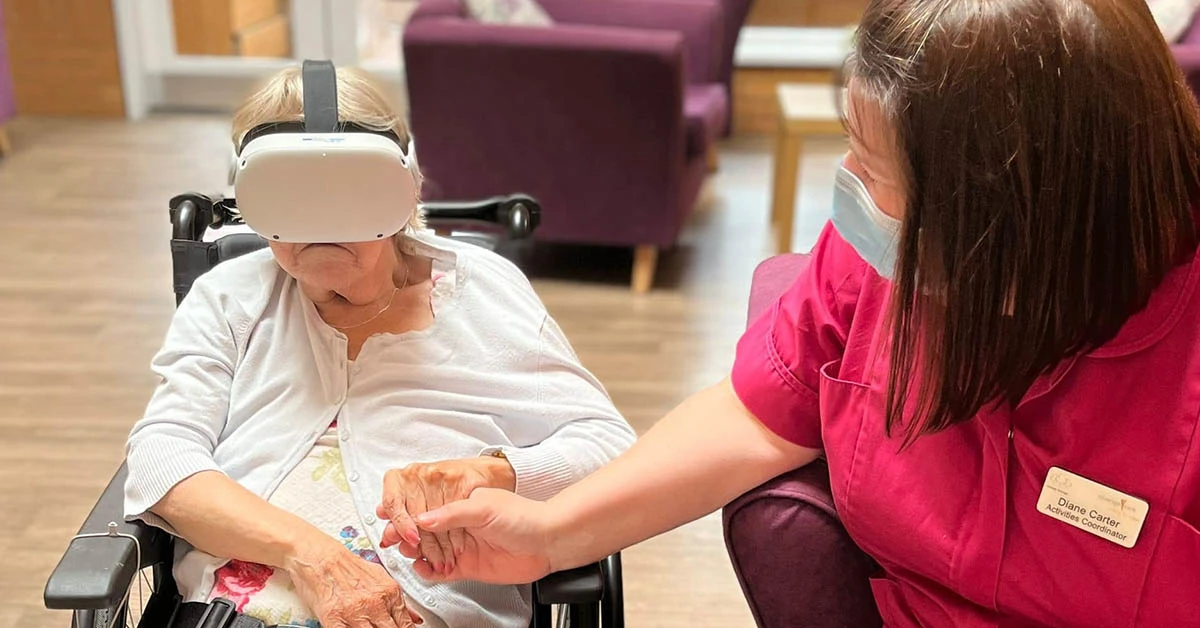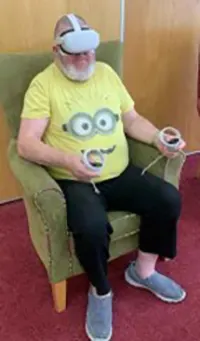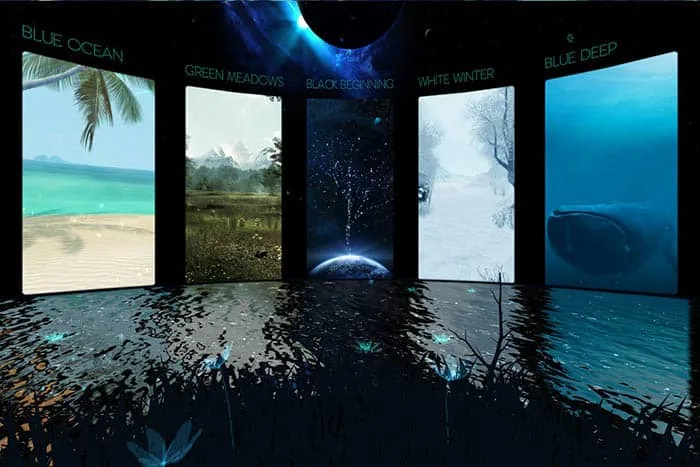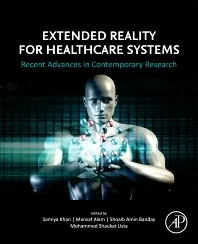Immersing older adults in VR to improve wellbeing
16 March 2023
By Marilynn Larkin

The lead researcher for a virtual reality study in UK care homes shares how it feels to make a profound difference in people’s lives — including her own
Virtual reality (VR) programs are showing promise as a therapeutic approach opens in new tab/windowto the mental and emotional health, wellbeing and quality of life for older adults. When it works, the experience can be life-changing for researchers as well as the participants.
That was the case for Dr Samiya Khan opens in new tab/window. After completing a PhD program in computer science at Jamia Millia Islamia opens in new tab/window in India, Samiya joined the Faculty of Science & Engineering at the University of Wolverhampton opens in new tab/window, UK, as a postdoctoral research fellow. Her most recent project there required that she work collaboratively to develop a solution to a societal problem. She decided to work with Greener Games opens in new tab/window, a UK-based VR company, to test the impact of its Nature Treks VR opens in new tab/window program on the mental health and mood of older adults with varying mental and physical challenges in UK care homes.

Samiya Khan, PhD
“Most of the research that I do is around big data analytics and data science, and the immediate impact of a technology is something you can see only in sectors like healthcare, where adoption is faster,” Samiya explained. “I was excited at the prospect of actually seeing results.”
Before she started this project, she read a lot of literature about extended reality (XR) — an umbrella term that includes VR, augmented reality and mixed reality opens in new tab/window.
“It was astonishing to learn that people are using these technologies for so many things, like pain management and managing anxiety among women who have had miscarriages,” she said. “I was intrigued by the prospect of exploring potential uses that can impact society.
“Age often brings a lot of physical and mental limitations, which is something I have seen with my grandparents. Working with older adults seemed like an amazing opportunity — and it was!”
Emotional responses

The island view, from the Nature Treks VP program, was among the most popular with test subjects.
The pilot study involved 52 participants (41 residents, mostly over age 75, and 11 staff over age 55) in seven UK care homes. The residents had mobility issues, some had cognitive impairment and others, dementia. Several had difficulty hearing and wore hearing aids.
A resident in a UK care home uses VR as part of Dr Samiya Khan’s study.
The aim was to do quantitative and qualitative analyses pre- and post- experimental data collection around the use of Nature Treks VR, which offers nine different experiences. Those experiences enable older adults to virtually visit locations they can no longer travel to, and opportunities to reminiscence about places they have visited in the past.
“There are repetitive aspects to Nature Treks that act as a memory stimulator for patients with memory problems,” Samiya explained. “It also gives caregivers significant information on an individual’s memory threshold, and a generic assessment of their physical and mental wellbeing.”
The pilot was divided into two phases. The first phase, referred to as “taster” sessions, provided a VR experience to all the residents, after which Khan and colleagues asked for their consent to enroll in the study. The second phase included three groups of sessions for the registered participants.

A resident in a UK care home uses VR as part of Dr Samiya Khan’s study.
Participants used Oculus (now Meta Quest opens in new tab/window) headsets in sessions that generally ran for 15 to 20 minutes. Given restrictions to residents’ schedules based on their health status and other commitments, the sessions were conducted progressively in three small cohorts.
The team adapted a standard questionnaire used to evaluate technology-based restorative interventions to assess participants’ pre-VR mental state and mood; participant-researcher interactions; and post-VR mental state and mood. Questionnaire scores, researcher observations and caregiver comments were all used as part of the qualitative analysis.
Participants chose from various environments, such as a tropical island, a forest and a mountainous landscape, and were free to navigate across them if they were capable of doing so. Therefore, questionnaire responses and anecdotes were based on participant-specific experiences.
“The highlight of the sessions were the emotional responses that we received from participants who had been in bed or in a wheelchair for years, and the stories that we got to hear about the holidays from their youth,” Samiya said. “It was heartening to hear about their experiences, challenges, loves and everything else that lies in between, and to know these were triggered by participating in our study.
“One woman had lost her husband and all she wanted to do was go to the island environment because she used to go with her husband to a sea-type setting for the holidays,’ Samiya said. “She never did anything — just sat there for extended periods of time enjoying the experience.”
Responding to a question in the post-VR questionnaire, the woman wrote that at the end of the session, she missed her husband. “My colleague who was administering the questionnaire said this was a very emotional moment for her. She realized the purpose of the experience was not just to restore some memories. It was about giving the individual a life again, helping her or him to remember the good moments in their life.”
In fact, Samiya said, “carrying out the VR sessions has been a life-changing experience for everyone in the team. It was a live demonstration of what social impact means and how technology can transform healthcare for the better.”
Managing challenges
Those who might like to run a similar study or simply provide the VR experiences in their particular settings should be aware of some of the challenges the researchers faced, Samiya noted. The team wanted to keep the same sets of residents throughout the study, but this wasn’t possible because of participants’ medical appointments, unwillingness to continue or other personal reasons, as well as the limited physical capacity of some.
“Some participants’ hearing issues were so severe they could not wear the headset with the audio on,” Samiya said. “We had to mute the headset because of their hearing aids, which caused a high degree of feedback. As a result, these individuals could have only limited or no VR experiences, despite their enthusiasm.”
Furthermore, some participants had neck and back problems, which also interfered with their ability to wear the VR headsets. “Better hardware is definitely needed and should be a future direction for work in this area,” Samiya advised.
Improving outcomes

Users can choose from various scenes in the Nature Treks VR program. These were the most popular scenes among subjects in Dr Samiya Kahn’s study.
Despite the challenges, 12 participants stayed with the program long enough for the researchers to assess the impact of VR on anxiety. “Generally, participant feedback suggests that nature-based VR experiences have a calming and relaxing effect,” Samiya said. “Some of the most popular environments were meadows, islands, underwater experiences and the African safari.”
The qualitative and quantitative analyses of the data also suggest that there was a significant improvement in mental state and mood scores, according to Samiya: “Scores improved more prominently for participants on regular anxiety medication — a finding that was corroborated by caregiver comments stating that they observed a reduction both in mood swings and the need to take the medication during the study period.” The trends were similar for the Mini Mental State Examination, which also suggested improvement.
Most participants didn’t have many regular visitors, nor could they visit others, Samiya pointed out:
Therefore, our visit and the VR experience were highlights of their days. One of the biggest takeaways from the study was that every single minute we spent with them is valued and they appreciated our efforts. It is overwhelming when someone who can hardly walk, hear or talk, comes up to you to tell you how much they look forward to seeing you. Their expression of gratitude is no less than an award and I will cherish it all my life.
An article describing the pilot in detail is in development and will be submitted to a peer-reviewed journal in the near future. Meanwhile, in a chapter in a book for which Samiya was a co-editor, called Extended Reality for Healthcare Systems: Recent Advances in Contemporary Research, she provides additional insights into the study and her motivation for pursuing it.
As a next step, her research team intends to carry forward the results and learnings from this pilot study to a larger study in partnership with Greener Games and Coverage Care Services opens in new tab/window, which provided access to the care home residents, to identify new areas of impact and leverage the development of customized VR solutions for social care.
Read a chapter by Dr Khan
Dr Samiya Khan is coeditor of a new book from Elsevier that focuses on real-world applications of virtual reality and related emerging technologies in health and medicine. Extended Reality for Healthcare Systems: Advances in Contemporary Research opens in new tab/window includes case studies that explain the ways in which these technologies have and can be used, while also taking readers through increasing evidence of benefit, best practices and challenges. Fifteen chapters provide a basis for launching and evaluating new projects, focusing on healthcare solutions that are inclusive and cost-effective. Dr Khan is the author of Chapter 2: “Clinical applications of extended reality opens in new tab/window.”
“Creating a book is a lengthy process, spanning, in our case, 20 months and involving many contributors,” Samiya said. “This can make management and communication challenging. My experience working with Elsevier, however, has been very smooth and without any communication hassles. The team is responsive and ensures that any conflicts or issues are resolved as quickly as possible. In my view, Elsevier lives up to its reputation of being one of the leading publishers in every sense.”

Contributor

ML
Marilynn Larkin
Writer and Editor for medical, scientific and consumer audiences
The Lancet